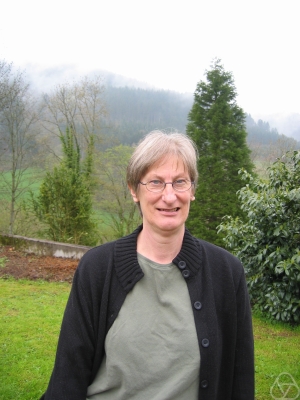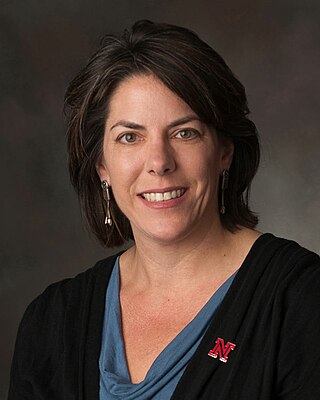Related Research Articles

In mathematics, an equivalence relation is a binary relation that is reflexive, symmetric and transitive. The equipollence relation between line segments in geometry is a common example of an equivalence relation. A simpler example is equality. Any number is equal to itself (reflexive). If , then (symmetric). If and , then (transitive).

In abstract algebra, a cyclic group or monogenous group is a group, denoted Cn, that is generated by a single element. That is, it is a set of invertible elements with a single associative binary operation, and it contains an element g such that every other element of the group may be obtained by repeatedly applying the group operation to g or its inverse. Each element can be written as an integer power of g in multiplicative notation, or as an integer multiple of g in additive notation. This element g is called a generator of the group.

Fan-Rong King Chung Graham, known professionally as Fan Chung, is an American mathematician who works mainly in the areas of spectral graph theory, extremal graph theory and random graphs, in particular in generalizing the Erdős–Rényi model for graphs with general degree distribution.
In mathematics, especially representation theory, a quiver is another name for a multidigraph; that is, a directed graph where loops and multiple arrows between two vertices are allowed. Quivers are commonly used in representation theory: a representation V of a quiver assigns a vector space V(x) to each vertex x of the quiver and a linear map V(a) to each arrow a.
In mathematics, more specifically in the field of ring theory, a ring R has the invariant basis number (IBN) property if all finitely generated free left modules over R have a well-defined rank. In the case of fields, the IBN property becomes the statement that finite-dimensional vector spaces have a unique dimension.

The algebraic connectivity of a graph G is the second-smallest eigenvalue of the Laplacian matrix of G. This eigenvalue is greater than 0 if and only if G is a connected graph. This is a corollary to the fact that the number of times 0 appears as an eigenvalue in the Laplacian is the number of connected components in the graph. The magnitude of this value reflects how well connected the overall graph is. It has been used in analyzing the robustness and synchronizability of networks.
Jessica Katherine Sklar is a mathematician interested in abstract algebra, recreational mathematics, mathematics and art, and mathematics and popular culture. She is a professor of mathematics at Pacific Lutheran University, and former head of the mathematics department at Pacific Lutheran.
Leonid Nisonovich Vaserstein is a Russian-American mathematician, currently Professor of Mathematics at Penn State University. His research is focused on algebra and dynamical systems. He is well known for providing a simple proof of the Quillen–Suslin theorem, a result in commutative algebra, first conjectured by Jean-Pierre Serre in 1955, and then proved by Daniel Quillen and Andrei Suslin in 1976.

MathPath is a mathematics enrichment summer program for students ages 11–14. It is four weeks long, and moves to a different location each year. MathPath is visited by mathematicians such as John H. Conway and Francis Su. It was probably the original, and is still one of the few, international residential high-end summer camps exclusively for mathematics and exclusively for students of middle school age.

Karen Vogtmann (born July 13, 1949 in Pittsburg, California) is an American mathematician working primarily in the area of geometric group theory. She is known for having introduced, in a 1986 paper with Marc Culler, an object now known as the Culler–Vogtmann Outer space. The Outer space is a free group analog of the Teichmüller space of a Riemann surface and is particularly useful in the study of the group of outer automorphisms of the free group on n generators, Out(Fn). Vogtmann is a professor of mathematics at Cornell University and the University of Warwick.
In mathematics, especially in the fields of universal algebra and graph theory, a graph algebra is a way of giving a directed graph an algebraic structure. It was introduced by McNulty and Shallon, and has seen many uses in the field of universal algebra since then.
In algebra, the Amitsur–Levitzki theorem states that the algebra of n × n matrices over a commutative ring satisfies a certain identity of degree 2n. It was proved by Amitsur and Levitsky (1950). In particular matrix rings are polynomial identity rings such that the smallest identity they satisfy has degree exactly 2n.
In mathematics, especially ring theory, the class of Frobenius rings and their generalizations are the extension of work done on Frobenius algebras. Perhaps the most important generalization is that of quasi-Frobenius rings, which are in turn generalized by right pseudo-Frobenius rings and right finitely pseudo-Frobenius rings. Other diverse generalizations of quasi-Frobenius rings include QF-1, QF-2 and QF-3 rings.
Joan Prince Hutchinson is an American mathematician and Professor Emerita of Mathematics from Macalester College.

Judy Leavitt Walker is an American mathematician. She is the Aaron Douglas Professor of Mathematics at the University of Nebraska–Lincoln, where she chaired the mathematics department from 2012 through 2016 and currently serves as the Associate Vice Chancellor for Faculty Affairs. Her research is in the area of algebraic coding theory.
In mathematics, a graph C*-algebra is a universal C*-algebra constructed from a directed graph. Graph C*-algebras are direct generalizations of the Cuntz algebras and Cuntz-Krieger algebras, but the class of graph C*-algebras has been shown to also include several other widely studied classes of C*-algebras. As a result, graph C*-algebras provide a common framework for investigating many well-known classes of C*-algebras that were previously studied independently. Among other benefits, this provides a context in which one can formulate theorems that apply simultaneously to all of these subclasses and contain specific results for each subclass as special cases.
In mathematics, a Leavitt path algebra is a universal algebra constructed from a directed graph. Leavitt path algebras generalize Leavitt algebras and may be considered as algebraic analogues of graph C*-algebras.
In mathematics, an ultragraph C*-algebra is a universal C*-algebra generated by partial isometries on a collection of Hilbert spaces constructed from ultragraphs.pp. 6-7. These C*-algebras were created in order to simultaneously generalize the classes of graph C*-algebras and Exel–Laca algebras, giving a unified framework for studying these objects. This is because every graph can be encoded as an ultragraph, and similarly, every infinite graph giving an Exel-Laca algebras can also be encoded as an ultragraph.

Mark Tomforde is an American mathematician and Professor of Mathematics at University of Colorado Colorado Springs. He works in the areas of functional analysis and algebra, and he earned his Ph.D. in mathematics at Dartmouth College in 2002. Tomforde's research interests are in operator algebras and C*-algebras, and he has made contributions to the study of graph C*-algebras and Leavitt path algebras. He was an invited speaker at the 2015 Abel Symposium, and he is a founding member of the Algebras and Rings in Colorado Springs (ARCS) center. He has also received several awards for his teaching and outreach efforts.
References
- ↑ Morita equivalence for rings with local units. Comm. Algebra 11 (1983), no. 8, 801–837.
- ↑ Rings with Local Units. Thesis (Ph.D.), University of Oregon. 1981. 82 pp, ProQuest LLC
- ↑ Sec. 1.7 of Leavitt path algebras. Lecture Notes in Mathematics, 2191. Springer, London, 2017. xiii+287 pp. ISBN 978-1-4471-7343-4; 978-1-4471-7344-1. Online Copy (PDF)
- ↑ Abrams, Gene; Aranda Pino, Gonzalo; The Leavitt path algebra of a graph. J. Algebra 293 (2005), no. 2, 319--334.
- ↑ Pere Ara, María A. Moreno, and Enrique Pardo. Nonstable K-theory for graph algebras. Algebr. Represent. Theory, 10(2):157–178, 2007.
- ↑ Sec. 1.7 of Leavitt path algebras. Lecture Notes in Mathematics, 2191. Springer, London, 2017. xiii+287 pp. ISBN 978-1-4471-7343-4; 978-1-4471-7344-1. Online Copy (PDF)
- ↑ Title slide and p.23 of "Leavitt path algebras: Entering Adulthood (d.o.b. May 31, 2004; Iowa City, Iowa)", slides from a talk given by Gene Abrams at the University of Iowa on March 30, 2018. Online Copy (PDF)
- ↑ List of 2004 CBMS conferences
- ↑ Leavitt path algebras: the first decade. Bull. Math. Sci. 5 (2015), no. 1, 59--120.
- ↑ Workshop on Graph Algebras at Málaga, Spain in 2006 website
- ↑ AMS Special Session on Graph Algebras in Analysis and Algebra held at the Joint Mathematics Meetings in 2010.
- ↑ Graph algebras: Bridges between graph C*-algebras and Leavitt path algebras, a five-day workshop held at Banff International Research Station from April 21--April 26, 2013. Conference Website , Online Problem Page from the Workshop.
- ↑ Leavitt path algebras: a primer and handbook. Lecture Notes in Mathematics, 2191. Springer, London, 2017. xiii+287 pp. ISBN 978-1-4471-7343-4; 978-1-4471-7344-1. Springer Book Page Online Copy (PDF)
- ↑ 2020 Mathematics Subject Classification (PDF)
- ↑ The Colorado Math Circle, members and organizers
- ↑ Colorado Café Scientifique talk by Gene Abrams
- ↑ Colorado Café Scientifique website
- ↑ Café Scientifique Mathematics in the Microbrewery: Fermat Meets Fermentation, MAA FOCUS, Volume 27, Issue 6, August/September 2007 Online Copy (PDF)
- ↑ The Graph Menagerie: Abstract Algebra and the Mad Veterinarian, Gene Abrams and Jessica K. Sklar, Math. Mag. 83 (2010), no. 3, 168--179. Online Copy (PDF)
- ↑ 1 Plus 1 Makes Engaging Book: Mother and Daughter Bridge Generations and Disciplines by Dana Mackenzie (January 2013), Swarthmore College Bulletin. Online Copy
- ↑ The Burton W. Jones Distinguished Teaching Award of the Rocky Mountain Section of the MAA, list of recipients